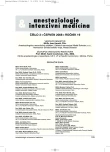Anticoagulation for extracorporeal renal replacement therapy in the critically ill
Authors:
Kroužecký Aleš; Novák Ivan; Raděj Jaroslav; Sýkora Roman; Chvojka Jiří; Karvunidis Thomas; Matějovič Martin
Authors‘ workplace:
JIP, I. interní klinika, Fakultní nemocnice a LF UK, Plzeň
Published in:
Anest. intenziv. Med., 19, 2008, č. 3, s. 154-158
Category:
Intesive Care Medicine - Review Article
Overview
Anticoagulation of the extracorporeal circuit is usually required to prevent its clotting during renal replacement therapy. However, anticoagulants may cause significant bleeding and critically ill patients are at increased risk of it. This article analyses the implementation, efficacy and safety of anticoagulation strategies in renal replacement therapy in the critical care setting and gives a summary of the causes of extracorporeal circuit blood clotting.
Keywords:
anticoagulation – renal replacement therapy – critically ill
Sources
1. Cutts, M. W. et al. Transfusion requirements during continuous veno-venous haemofiltration: the importance of filter life. Intensive Care Med., 2000, 26, 11, p. 1694–1697.
2. Davenport, A. The coagulation system in the critically ill patient with acute renal failure and the effect of an extracorporeal circuit. Am. J. Kidney Dis., 1997, 30, 5, Suppl 4, p. S20–S27.
3. Opatrný, K. Jr. Biokompatibilita dialyzačních mebrán. Plzeň: Euroverlag Plzeň, s. r. o., III/2000.
4. Cardigan, R. A. et al. Activation of the tissue factor pathway occurs during continuous venovenous hemofiltration. Kidney Int., 1999, 55, 4, p. 1568–1574.
5. Levi, M., Opal, S. M. Coagulation abnormalities in critically ill patients. Crit. Care, 2006, 10, 4, p. 222.
6. Jean, G. et al. Central venous catheters for haemodialysis: looking for optimal blood flow. Nephrol. Dial. Transplant., 1997, 12, 8, p. 1689–1691.
7. Baldwin, I. et al. Blood flow reductions during continuous renal replacement therapy and circuit life. Intensive Care Med., 2004, 30, 11, p. 2074–2079.
8. Mehta, R. Anticoagulation for continuous renal replacement therapies. In Ronco, C., Bellomo, R. Critical Care Nephrology. Dordrecht: Kluwer Academic Publisher, 1998, p. 1199–1211.
9. Ronco, C. et al. Effects of different doses in continuous veno-venous haemofiltration on outcomes of acute renal failure: a prospective randomised trial. Lancet, 2000, 1, 356, 9223, p. 26–30.
10. Hirsh, J. et al. Heparin and low-molecular-weight heparin: mechanisms of action, pharmacokinetics, dosing, monitoring, efficacy, and safety. Chest, 2001, 119, 1 Suppl, p. 64S–94S.
11. Oudemans-van Straaten, H. M. et al. Anticoagulation strategies in continuous renal replacement therapy: can the choice be evidence based? Intensive Care Med., 2006, 32, 2, p. 188–202.
12. Farooq, V. et al. Serious adverse incidents with the usage of low molecular weight heparins in patients with chronic kidney disease. Am. J. Kidney Dis., 2004, 43, 3, p. 531–537.
13. Lindhoff-Last, E. et al. Use of a low-molecular-weight heparinoid (danaparoid sodium) for continuous renal replacement therapy in intensive care patients. Clin. Appl. Thromb. Hemost., 2001, 7, 4, p. 300–304.
14. Vargas Hein, O. et al. Hirudin versus heparin for anticoagulation in continuous renal replacement therapy. Intensive Care Med., 2001, 27, 4, p. 673–679.
15. Kozek-Langenecker, S. A. et al. Effect of prostacyclin on platelets, polymorphonuclear cells, and heterotypic cell aggregation during hemofiltration. Crit. Care Med., 2003, 31, 3, p. 864–868.
16. Kozek-Langenecker, S. A. et al. Anticoagulation with prostaglandin E1 and unfractionated heparin during continuous venovenous hemofiltration. Crit. Care Med., 1998, 26, 7, p. 1208–1212.
17. Dellinger, R. P. et al. Surviving Sepsis Campaign: international guidelines for management of severe sepsis and septic shock: 2008. Crit Care Med., 2008, 36, 1, p. 296–327.
18. Rossmann, P. et al. Protamine-heparin aggregates. Their fine structure, histochemistry, and renal deposition. Virchows Arch., 1982, 40, 1, p. 81–98.
19. Mehta, R. L. et al. Regional citrate anticoagulation for continuous arteriovenous hemodialysis in critically ill patients. Kidney Int., 1990, 38, 5, p. 976–981.
20. Gabutti, L. et al. Citrate anticoagulation in continuous venovenous hemodiafiltration: a metabolic challenge. Intensive Care Med., 2002, 28, 10, p. 1419–1425.
21. Tan, H. K. et al. Continuous veno-venous hemofiltration without anticoagulation in high-risk patients. Intensive Care Med., 2000, 26, 11, p. 1652–1657.
22. van der Voort, P. H. et al. Filter run time in CVVH: pre- versus post-dilution and nadroparin versus regional heparin-protamine anticoagulation. Blood Purif., 2005, 23, 3, p. 175–180.
23. Gupta, M. et al. Regional citrate anticoagulation for continuous venovenous hemodiafiltration using calcium-containing dialysate. Am. J. Kidney Dis., 2004, 43, 1, p. 67–73.
24. Kramer, L. et al. Citrate pharmacokinetics and metabolism in cirrhotic and noncirrhotic critically ill patients. Crit Care Med., 2003, 31, 10, p. 2450–2455.
25. Meier-Kriesche, H. U. et al. Increased total to ionized calcium ratio during continuous venovenous hemodialysis with regional citrate anticoagulation. Crit Care Med., 2001, 29, 4, p. 748–752.
26. Opatrny, K. Jr et al. A clinical study to assess the effect of heparin in dialyzer rinsing solutions. Int. J. Artif. Organs., 1997, 20, 2, p. 112–118.
27. Opatrny, K. Jr et al. The effect of heparin rinse on the biocompatibility of continuous veno-venous hemodiafiltration. Int. J. Artif. Organs., 2002, 25, 6, p. 520–528.
Labels
Anaesthesiology, Resuscitation and Inten Intensive Care MedicineArticle was published in
Anaesthesiology and Intensive Care Medicine

2008 Issue 3
Most read in this issue
- A 39-year patient with a severe haemorrhagic-traumatic shock due to a gunshot, with a left-sided penetrating chest wound resulting in haemothorax, pneumothorax and massive blood loss was treated in the Czech Field Hospital ROLE 2 plus after a terrorist attack in Kabul. The initial Sequential Organ Failure Assessment (SOFA) of 13 points improved thanks to damage control surgery and adequate perioperative care to 5 points, increasing the chance of survival from 5% to 80%. The patient was transported to his homeland on the 3rd postoperative day where he recovered.
- Selective bronchial intubation with the UniventR tracheal tube in children
- Research in Anaesthesiology and Resuscitation in the second half of 20th Century
- Preventive measures of nosocomial infection in ventilated patients – current status
